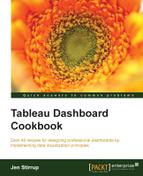In this chapter, we will cover the following recipes:
- Fun with filters – grouping your data with clarity
- Hierarchies for revealing the dashboard message
- Classifying your data for dashboards
- Actions and interactions
- Drilling into the details
- Working with input controls
A key aspect of dashboarding is that a dashboard should convey its message clearly and simply in order to help team members draw the right conclusions. Dashboards became more interesting to businesses when Kaplan and Norton introduced their Balanced Scorecard methodology in the 1990s. This introduced the dashboard as a way of measuring business performance with a particular focus on Key Performance Indicators (KPIs), which helped to measure the success and direction of the organization. With the Enron scandal in 2001, businesses realized that it was perfectly possible to drown in data and not really understand what is going on at the executive level. Therefore, the dashboard concept gained renewed interest, which continues to date.
Creating dashboards is both a top-down and bottom-up process. It is top-down because we need to be able to summarize and put all of the pieces together. It is also a bottom-up process because the dashboard is made up of its constituent parts.
In this chapter, we will look at making the most of the constituent parts, so this chapter uses the bottom-up approach. Later on in this book, we will look at top-down processes while creating the dashboard.
In order to achieve the objective of conveying the message of the data effectively, users should be able to interact with data to get the information they need. The subject of this chapter is to help you create dashboards that will facilitate team members to get the most out of their dashboards by setting up interactivity, navigation, and an awareness of the underlying data. According to the guidelines, such as Eight Golden Rules of Interface Design by Professor Ben Shneiderman, it is vital to allow users to interact with the data by offering the filtering, categorizing, and zooming in functionalities to access the details. Business users gain trust in the data by having a look at the details, which allows them to validate the truth of the data.
Interacting with dashboards is a vital way of allowing business users to understand the data better. It also allows components to tell stories individually as well as provide a coherent story of the data as a whole.
From a practical perspective, it allows us to make the most of the space. Instead of having lots of reports with different dimensions and filters, we can help the user move towards Self-Service Business Intelligence (SSBI). We do this by furnishing the user with the data that they require in a dashboard format while allowing them to focus on the dimensions and attributes that are most important to them.
Dashboards are different from reports in that users expect to be able to view the data and understand it at a glance. In other words, very little interaction is required as the necessary data should be presented; that said, it is expected that the data is highly integrated and that the various elements of the dashboard are highly coupled together.
This section will help you to see the different ways of facilitating interactions with the data on the dashboard while getting the message of the data across as quickly and effectively as possible. Currently, we are in a bottom-up part of dashboard creation, and not top-down. In Tableau, we create worksheets that then go into the dashboards. This is why we will initially focus on worksheets.
